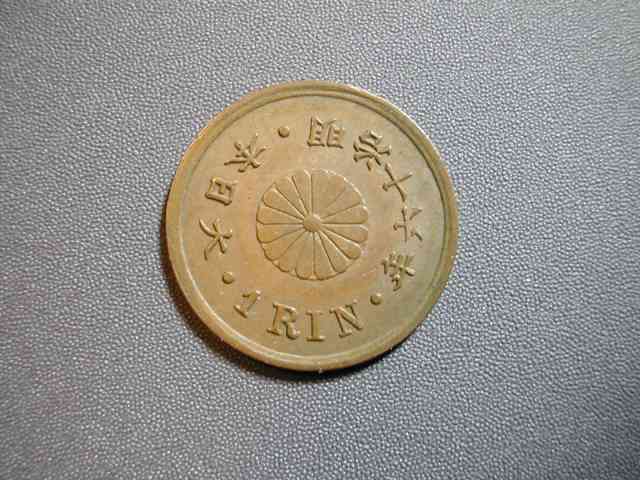1 rin (Copper)
一厘銅貨


Coined in Meiji 17, Diameter 15.7mm, weight 0.935g
Data
- Issued / Banned: Meiji 7(1874) / Showa 28(1953)
- Manufacturing Period: Meiji 6 (1873) - Meiji 17(1884)
- Number of Mintage: 44,491,550
- Material: Copper:980 Tin:10 Zinc:10
- Diameter: 15.75mm
- Weight: 0.91g
- Design: Face - "一厘" (Ichi rin, 1 Rin), Back - Emblem of chrysanthemum
History of Issuance
- Meiji Era of Japan started from 1868 by restoring governing from Tokugawa Bakufu (Shogunate) to Meiji New Government. New government made a new currency system and "New Coinage Decree" (Shinka Jorei) was promulgated in 1871 (Meiji 4). This decree determines the new currency unit "Yen(円), Sen(銭), Rin (厘)" instead of "Ryo(両), Shu(朱), Bu(分), Mon(文)".
- In the new decRee, 1 Yen is equal to 1 Ryo or 4,000 Mon (Value of a Koban, ). 1 Yen is equal to 100 Sen or 1,000 Rin.
- The design of 1 rin in the new decree was different from the one of the picture in this page. 1 Rin ("一厘") is written in horizontal and the rising sun is located in the center, which was a pattern coin and not issued and circulated.
- The first 1 Rin coin is issued in Meiji 7, and pattern coin was also made.This coin uses "MIL" which means 1/1000 in English instead of "Rin", however, the 'Mil' was not used finally.
Rarity
- The coins made in Meiji 9 and Meiji 13 are extremely rare and expensive, and also there are too many fakes from toy-like ones to very elaborate ones. It is one of reasons why there are so many fakes that the design of this coin is very simple. The one I own is very thick.
- Coins of general mintage year and condition are not so expensive, would be got in several hundred yen. I feed that there are less coins of very bad conditions.
Comments
- Very thin coin. It seems to be easy to bend but it is stronger than expected from the appearance, much firmer than the tin coins issued during WW II in Japan.
- Old coins of low face value in Edo era were still valid for a while, for example, "Kan-ei Tsuho (Copper)" could be used as 1 rin until 1953 (Showa 28), and "Tempo Tsuho" could be used as 8 rin until 1896 (Meiji 29). I think it would result in that 1 rin was not circulated enough and as a result less existing coins are in bad condition.
- The production process of this coin was different from the usual one . Coins are usually made by coining to a small metal disk with a stamp made with harden metal. however, this coin are made by the other process, unfortunately I don't know the details. It seems that the edge of this coin is not sharp but round-like compared with the other coins in modern age.
Other Japanese coins in this period
- New 1 Yen (Silver)
- Dragon 50 Sen (Silver) J
- Dragon 20 Sen (Silver) J
- Dragon 10 Sen (Silver) J
- Dragon 5 Sen (Silver) J
- 2 Sen (Copper) J
- Dragon 1 Sen (Copper)
- 1/2 Sen (Copper)
Apr 15, 2022


 Move to Home(J)
Move to Home(J)